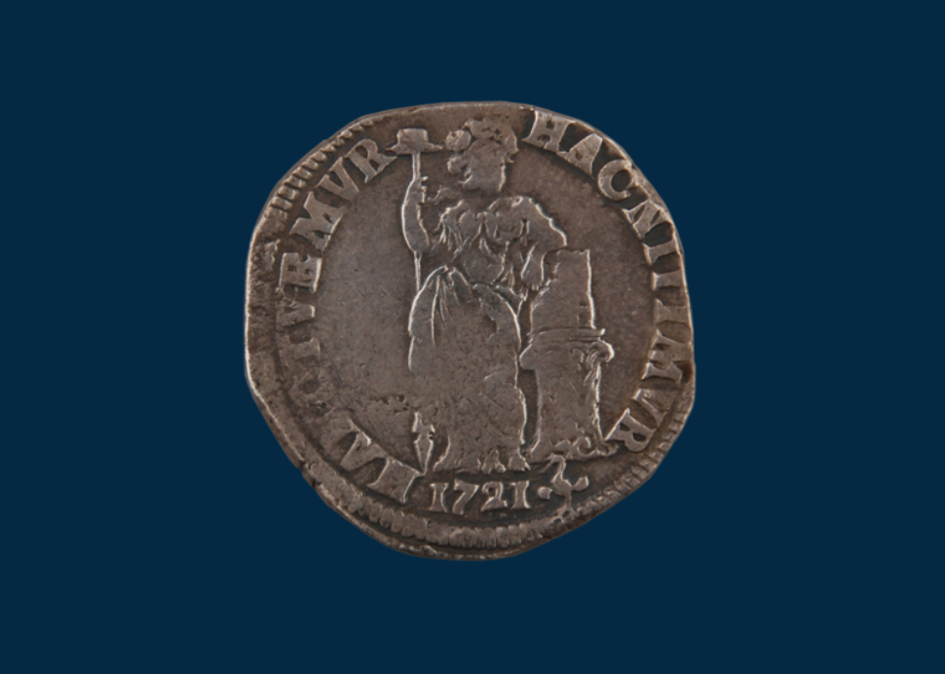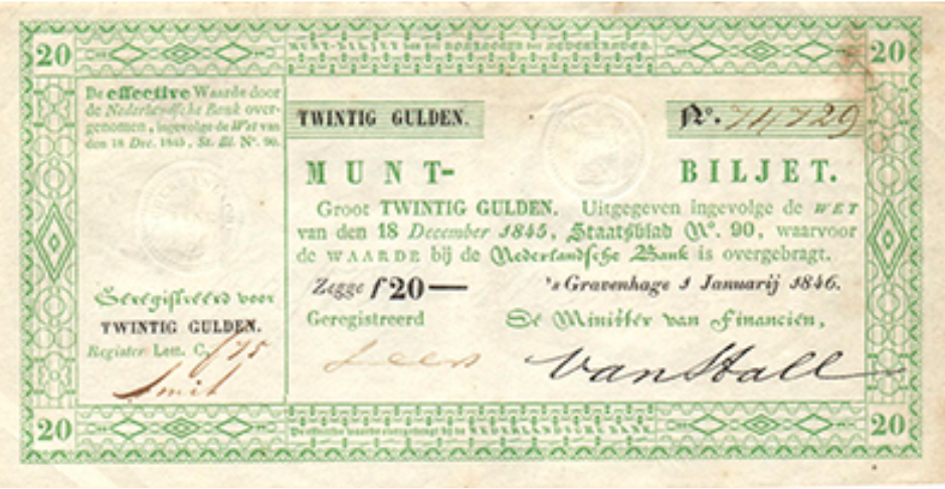9.4
7.521 Reviews

English
EN
In the Previous piece we described how the Dutch Central Bank (DNB) was founded in 1814. The paper money issued by DNB, which was initially not widely accepted, was also discussed. The coins were omitted in the previous article, but it is certainly worth taking a closer look at. Which coins were used in the Netherlands after DNB was founded?
Before we look at the double standard in the Netherlands, it is first important to look at how coin standards work. It has happened that both gold and silver coins were in circulation in a country, but that there was no fixed value ratio between the two types of currency. It is better to speak of two separate systems and this system is therefore called a parallel standard.
The value of silver and gold coins fluctuates and can change at any time in such a system, so one has to keep a constant eye on the ratio. It is a difficult system, in which the unit of account itself is subject to change. Nevertheless, the parallel standard has functioned in China and England for a long time, as the book statesMoney by Wim Boonstra.
But if the government determines that there is a fixed ratio between the two currencies, there is no longer a parallel standard. In that case, it is referred to as a double or bimetallistic standard. This value ratio causes problems if the market value of one of the metals changes, for example due to a difference in supply and demand of the metals on the world market.
For example, if a country has a double standard with gold and silver coins, it leads to problems if proportionally more silver flows into the country. The market value of the silver in the coins actually decreases, but because the face value of the coins is set by the government and is above the market value of silver, it pays to mint coins from the silver and make payments with them. Because coins are minted, the amount of non-monetary silver decreases, causing the price of silver to rise again.
In this way, one takes advantage of the difference in value that has arisen between silver as a metal and silver in the form of coins. If the coins are worth more, more coins will be put into circulation. If the silver is worth more, coins will be melted down and withdrawn from circulation. Thus, a corrective mechanism is created, causing the price to recover.
On the other hand, there are conceivable situations in which gold coins become undervalued, for example if gold is exported and has become scarce. The face value of the gold coins is then below the market value of the gold in the coins. It pays not to make payments with the gold coins. The gold coins are taken out of circulation and melted down into jewellery or gold bars, for example. As a result, the amount of non-monetary gold increases, which in turn lowers the price of gold. This process continues until the value ratio returns to the established value ratio.
Before the Coinage Act of 1816, the monetary system in the Netherlands was still very confusing. As in the Golden Age was the case, there were still a large number of coins in circulation at the beginning of the nineteenth century. After all, the gold and silver coins of previous times had retained their value, with the result that coins from various cities and provinces were still accepted, although many of these coins were already in place by thenPruned. When pruning coins, pieces of metal are cut off the edge, which lowered the intrinsic value of the coin. 
Old provincial mint from Overijssel, the edges of the coin have been pruned (Source; Mazereeuw-Antiques Dealer)
Therefore, steps were taken to reduce the number of coins that were accepted. In 1816, the coinage law introduced the decimal system, in which a guilder consisted of one hundred cents and that guilder also became the unit of account in the Netherlands. From that moment on, prices were only expressed in guilders in most of the Netherlands, as can be heard in the lectures of economist Edin Mujagic.
With the Coinage Act From 1816 it was decided which standard coins would be minted. It was also decided that both silver and gold coins would be put into circulation. For example, there was a guilder coin with 9.613 grams of fine silver, but also a ten-guilder coin with 6.056 grams of fine gold. Of course, a king also had a corresponding coin. That is why, from 1817 onwards, guilders were minted with the king on the face of the coins.
The fact that the use of the guilder was not yet widespread at the beginning is evident from the difficult acceptance in the south of the Netherlands. There, the French franc, which had been circulating for years before the coinage law of 1816, was still strongly preferred. The fixed rate at which francs could be exchanged for guilders was fixed at 47.25 cents per hundred francs.
But because the French franc was actually worth less than the fixed exchange rate due to its lower silver content, silver guilders were transported to France to be melted down into francs again, according to the book De Nederlandsche Bank by Wim Vanthoor. It would never be possible to introduce the guilder in the southern part of the Netherlands. In 1832, Belgium became independent and chose the French franc as itsmonetary unit.
Wim Vantoor's book also describes well how complicated it was to choose the right standard. In 1836, a commission was set up to advise the king on the improvement of the coinage. Because the committee was not unanimous on the question of whether there should be a double, a gold or a silver standard, the Dutch Central Bank was also asked for advice.
DNB could live with a double standard. The condition was that an amount was levied if coins were to be minted or melted down. This so-called coinage was necessary to limit the fluctuation in the price of silver and gold. According to DNB, this prevented speculation with silver and gold by either melting down the metals or having them minted into coins.
If a single standard was chosen, DNB preferred a silver standard instead of a gold standard. Silver money was exported less quickly, because a large weight had to be transported quickly. After all, a guilder contained 9.613 grams of fine silver and a ten-guilder coin contained only 6.056 grams of fine gold. Meltdown practices nevertheless took placeAlways place, because the silver guilder in the Dutch East Indies was worth more than the face value of the guilder.
DNB was also concerned that it would have to use the interest rate instrument more quickly if a gold standard was chosen. Due to the high value of gold, a small deviation in the exchange rate already resulted in a flow of gold, because people could then profit from exchange rate differences. As a result, the Dutch Central Bank was forced to change interest rates more quickly with a gold standard than with a silver standard.
For practical reasons, silver was therefore preferred by DNB. Subsequent coinage laws no longer included gold coins. From that moment on, gold coins could be exchanged at the Dutch Central Bank. From then on, the gold coins were only used for international trade. Because old provincial coins and gold coins were withdrawn, there was a shortage of money. This shortage was compensated by the introduction of a series of coin notes in 1846 and in 1849.
Coin notes are different from banknotes. Coin notes were issued by the Ministry of Finance and not by DNB. The banknotes were also completely covered by precious metals and the banknotes were initially intended mainly to clean up the monetary system. The series of notes of 1846 were intended to replace the old provincial coins. In 1849, coin notes were issued to replace gold coins. It was not until 1877 that all provincial coins were replaced. Coin notes were therefore used for a long time.

Coin note from 1846. Coin notes from the nineteenth century are now worth a lot of money. (Source; Heritage Europe)
Although paper money was initially accepted at a very minimal rate, acceptance grew significantly with the introduction of currency notes. It was not until 1904 that banknotes were withdrawn from circulation, but the Dutch government would have to withdraw the banknotes from the shelves again during the First World War due to the great scarcity of silver. From the second half of the nineteenth century onwards, banknotes also increasingly found their way into the wallets of the Dutch.
In the end, the Netherlands was forced to follow the example of other countries when the gold standard was introduced in other countries. The period that followed would be known as La Belle Époque, a period of stability and increasing world trade. During that period, the gold standard was also introduced in the Netherlands. In the next article, the gold standard in the Netherlands will be discussed.
![]() Have a look at us YouTube channel
Have a look at us YouTube channel
On behalf of Holland Gold, Paul Buitink and Joris Beemsterboer interview various economists and experts in the field of macroeconomics. The aim of the podcast is to provide the viewer with a better picture and guidance in an increasingly rapidly changing macroeconomic and monetary landscape. Click here to subscribe.
